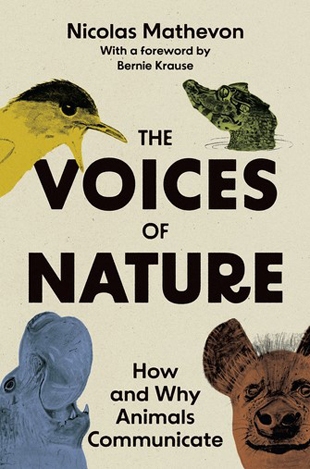I love this book for how grounded it is in real science and yet how earnestly the scientist who wrote it wants to communicate with non-scientists. He uses exclamation points, for instance, to demonstrate enthusiasm. Here’s one example, where we see his delight in the evidence he’s sharing:
“If 2000 years ago Pliny the Elder had already noted in his Natural History that the parrot was a good imitator, it is to the Austrian Ferdinand Pernau that we owe the first documented observations on the learning of song by birds. That was in 1720!”
Here’s another example, when the author explains what is often called the “dance of bees,” the way they communicate with each other about the existence of new flowers: “The angle formed between the axis of the bee’s walk along one of the honeycombs and the vertical axis corresponds to the angle formed between the direction of the sun and the direction of the flowers when exiting the hive. Simply incredible!”
Author Nicolas Mathevon is a professor of neuroscience and animal behavior. He’s a pioneer in a field called bioacoustics, aimed at understanding animal acoustic communications. He studies “how animals make and hear sounds, what information is encoded in their sound signals, what this information is used for in their daily lives, and also how their acoustic communication systems have developed over the history of life.”
This book explains this communication for those interested in the complex, little-understood lives of non-human creatures and shows how this knowledge also helps humans understand their own communication systems. When we laugh, or scream, or cry, or whisper, are we doing what animals, birds, and reptiles are doing, when they do similar things with their voices? And, if so, what can we then learn about them and about us?
You meet hyenas, bearded seals, chimpanzees, mice, fish, and birds here. Some of the evidence discovered points to evolutionary explanations for how creatures communicate. Other evidence points to what creatures have learned.
There is also discussion of how noise due to human activities affects animals’ communication, both in the air and underwater. In scientific terms this means “Anthropophony affects biophony.” It turns out that animals sometimes “turn up their volume” (those are my words) in response; for example, “Underwater, the humpback whale increases the power of its song when the background noise due to human activities increases.”
Chapter 15, “The Acoustic Expression of Emotions,” ponders parallels to human lives. Tail posture, eye rolling, and bristling fur are features of many animals and birds expressing emotions, but so are the changes in their voices. Perhaps more importantly, when one animal communicates with another (and so it is the same for humans), our voices are pregnant with acoustic signals that “encode the emotions of the sender.”
The opportunities for being more present to our surroundings and more intentional in our vocalizing and our listening skills comes through clearly. Methevon’s book left me thinking, if a baby crocodile does this well, so should I.
